
Physetica is a genus of moths of the family Noctuidae. This genus is endemic to New Zealand.

Sabatinca quadrijuga is a species of moth belonging to the family Micropterigidae. This species is endemic to New Zealand and is found in the Dunedin area and in Southland. The range of S. quadrijuga overlaps with the range of S. caustica.S. quadrijuga was first scientifically described by Edward Meyrick in 1912. As a result of its predominantly black forewings this species looks similar to a small caddisfly. The adults of this species are on the wing from September to November. Larvae feed on leafy liverwort species and the adults likely feed on fern spores or sedge pollen. The species prefers to live in well lit but damp mossy habitats. The nearest relative of S. quadrijuga is S. aurantissima.

Physetica prionistis is a moth of the family Noctuidae. It was described by Edward Meyrick in 1887. It is endemic to New Zealand and is widespread throughout the North, South and Chatham Islands. This species can be found in open clearings of shrubland and forest at altitudes from sea level up to the alpine zone. Adults are on the wing throughout the year and are attracted to sugar traps and occasionally to light. The life history of this species is unknown as are the larval host species.
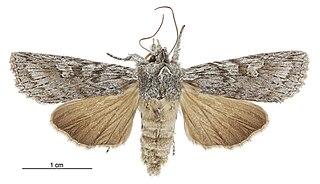
Physetica phricias is a moth of the family Noctuidae. It is endemic to New Zealand. It is wide spread in the South Island and inhabits shrubland. The host of the larvae of this species is matagouri. The adult moths are on the wing from September to May and July, and are attracted both to light and sugar traps.They are a faster-flying species and remain active even during windy conditions. P. phricias can be confused with some forms of P. sequens. However P. phricias can be distinguished as it has a less marbled appearance to its forewing.
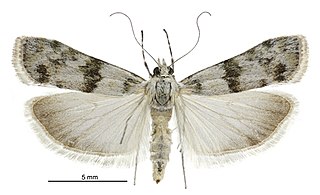
Eudonia asaleuta is a moth of the family Crambidae. It was described by Edward Meyrick in 1907. It is endemic to New Zealand and has been collected in the South Island in the West Coast, Fiordland,Canterbury, Otago and Southland regions. This species inhabits bare shingle areas as well as tussock habitat with few trees or scrub at altitudes of under 1000 m. Adults are on the wing from November to February.
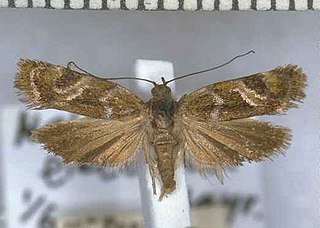
Hierodoris electrica is a moth of the family Oecophoridae. It was described by Edward Meyrick in 1889. It is endemic to New Zealand, where it has been reported from the northern and southern parts of the South Island. The larva of H. electrica has yet to be described. The wingspan is between 15 and 16.5 mm. The ground colour of the forewings is dark brown, with narrow yellow scales overlaying this base colour. The hindwings are brown. The known larval host species is Olearia nummulariifolia.

Proteuxoa comma is a species of moth in the family Noctuidae. It is endemic to New Zealand. It can be found in the lower half of the North Island and throughout the South Island, although it appears to be more frequent on the eastern side of these islands, and also is present in Stewart Island. P. comma is very similar in appearance to P. tetronycha but can be distinguished as it is a larger moth with slightly different colouration on, as well as shape of, its forewings. This species pupates in the soil. The adult moths are on the wing from December to April. P. comma may possibly be declining in population and as at 2017 a reassessment of its conservation status is regarded as being needed.

Austramathes purpurea is a species of moth in the family Noctuidae. It is endemic to New Zealand and can be found throughout the North and South Islands but has yet to be recorded at Stewart Island. It inhabits native forest. This species might possibly be confused with A. pessota, however this latter species does not have the purple hue to the forewings. The larvae of A. purpurea feed primarily on māhoe but have been recorded as feeding on, and have been reared on, narrow-leaved māhoe. The larvae pupate in a silken cocoon on moss covered ground. Adults can be found on the wing during the months of March to January but mainly occur during New Zealand's late autumn, winter, and spring. Light trapping may not be the most efficient technique for collecting this species.

Bityla defigurata is a moth of the family Noctuidae. It is endemic to New Zealand.
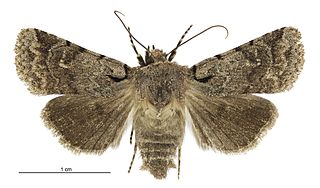
Austramathes fortis is a species of moth in the family Noctuidae. It is endemic to New Zealand and is found in both the North and the South Islands but has yet to be recorded at Stewart Island. It can be found in shrubland containing its host species at a range of altitudes from sea-level up to 1840 m. The larvae of this moth feed on several Melicytus species including M. crassifolius, M. alpinus, M. macrophyllus and M. novae-zelandiae. The larvae pupate in a cocoon of silk at the base of its host plant. It can take between 25 and 45 days before the adult moth emerges. Adults can be found on the wing during the months of July to March. The adults tend to be on the wing in twilight hours but have also been known to be active during the late afternoon. They are attracted to light but this behaviour may limit the number seen at light traps. The distinguishing feature of this moth is the curved black line at the base of its forewing. This species is unlikely to be confused with any other species in its range but it is very similar in appearance to A. squaliolus. However this latter species is only found on the Chatham Islands.

Austramathes pessota is a species of moth in the family Noctuidae. It is endemic to New Zealand and is found in Northland, in the southern North Island and in the South Island, mainly on the eastern side of that island but is also present in Fiordland. It is not regarded as being present in either Dunedin or the Southland district. This species lives in shrubland at altitudes ranging from sea-level up to subalpine. As at 2017, the larvae have yet to be described or photographed but it is known that they feed on Melicytus alpinus and it is likely that Melicytus micranthus is also a host. Adults of this species are distinctively patterned and coloured. Its appearance differs from its close relatives such as A. purpurea as it lacks the purple hue that can be seen on the latter species forewings. It also differs from A. coelacantha as it is much darker and has a distinctive small, round, pale mark on its forewing. Adults are on the wing from December to April.

Ichneutica dione is a moth of the family Noctuidae. It is endemic to New Zealand. This moth species is closely related to I. ceraunias and is very similar in appearance to that species. However I. dione has a much more restrictive range, being found only in the alpine zone and hills of the South Island and is less commonly collected. Adults of the species are on the wing from December to February and although sometimes can be found flying during the day, they are more commonly seen at night.
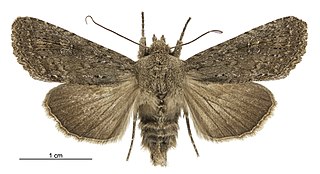
Physetica homoscia is a species of moth of the family Noctuidae. It is endemic to New Zealand and is found throughout New Zealand including in the Auckland Islands. This species inhabits places where its host plants are common and this includes costal dune habitat. It lives at a wide range of altitudes from sea-level up to at least 1750 m. The larvae of P. homoscia feed on Ozothamnus leptophyllus and Ozothamnus vauvilliersii. They are very active and drop to the ground when disturbed. Larvae are parasitised by a species of fly. This species pupates in the soil and the pupa life stage lasts for approximately 6 weeks. The adult moths are on the wing from September to June and are attracted to light. The adults of P. homoscia might possibly be confused with Ichneutica moderata however this latter species lacks the small white dots on the forewing veins of P. homoscia. Adults might also be confused with P. temperata but P. homoscia is significantly larger in size.

Physetica temperata is a species of moth of the family Noctuidae. It is endemic to New Zealand and found in the North Island and the top of the South Island in coastal areas. P. temperata is unlikely to be confused with other species in its range, even though it is not distinctively patterned. It is possible that males might be confused with males of P. homoscia but this latter species is much larger. P. temperata can be distinguished from P. caerulea as the former species has forewing veins that are marked black and a chequered forewing fringe. The adults of this species are on the wing from September to March. The life history of this species has not been well documented although it is thought that larval host species is Ozothamnus leptophyllus.
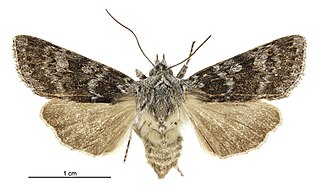
Physetica cucullina is a species of moth of the family Noctuidae. It is endemic to New Zealand and can be found throughout the South Island, apart from in the Nelson district with the exception of the St Arnaud Range where it is present. It is likely to be also resident in Stewart Island. P. cucullina lives in shrubland at subalpine and alpine zones but can occur at sea-level in the more southern regions. The life history of this species is poorly documented. There is only one known record in the New Zealand Arthropod Collection of the larvae of this species having been reared. These larvae were reared on Leucopogon fraseri. Adults of this species is on the wing from October to March and are attracted to light. P. cucullina is almost identical in appearance to P. funerea. The only reliable distinguishing feature between the two species is the antennae of the male. P. cucullina is also very similar in appearance to P. sequens but P. sequens lacks the narrow black line on the forewing dorsum area that can be present on the forewings of P. cucullina.

Physetica funerea is a species of moth of the family Noctuidae. It is endemic to New Zealand and is found only in the western and central parts of the South Island. This species inhabits shrubland in the subalpine and alpine zones. The life history of this species is unknown as are the larval host species. Adults of this species are on the wing from October to February. This species is almost identical to P. cucullina with the only difference between the two species being the structure of the male antennae. P. funerea is also similar in appearance to P. sequens, but the latter species tends to have a prominently underlined kidney-shaped mark nearer to the outer edge of the forewing.
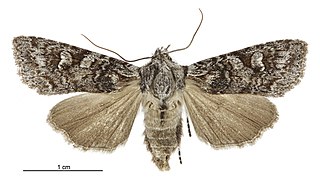
Physetica longstaffi is a species of moth of the family Noctuidae. It is endemic to New Zealand and found in the North and South Islands. This species lives in open habitats and shrublands, at altitudes ranging from the low alpine zone down to sea-level. As at 2017 the biology of this species is in need of further investigation as there is no published description of the larvae of this species nor have larval specimens been preserved in collections. There is also confusion over the possible larval host plants for this species. This species is on the wing from February to May. There is also a record from the North Cape in December. The adults of this species is attracted to light. P. longstaffi might possibly be confused with P. sequens or P. phricias. However unlike both P. sequens and P. phricias, P. longstaffi has a large oval mark near the centre of the forewing. Other distinguishing features include further differences in the colouration of the forewings of P. longstaffi as well as differences in the third labial palp segment of the male and differences in the shape of the male genitalia.
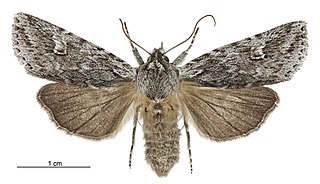
Physetica sequens is a species of moth of the family Noctuidae. It is endemic to New Zealand and can be found throughout the North and South Islands. It appears to be more common in the North Island than the South Island, and lives in open native shrublands, peatlands, Northland gumland, inland volcanic dunes, and Dracophyllum-dominated areas at altitudes that range from sea level to the alpine zone, up to at least 1600 m. Larvae of this species have been successfully reared on Leucopogon fasciculatus and Leptecophylla juniperina. The adults of this species are variable in appearance and are on the wing from September to March. P. sequens is similar in appearance to P. phricias but can be distinguished as P. phricias has a narrow black line along the dorsum of its forewing that P. sequens does not. P. sequens is also similar in appearance to P. cucullina however the forewing dorsum area of P. sequens does not have the narrow black line that is frequently present on P. cucullina forewings.
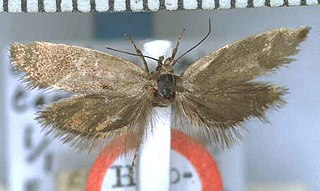
Tingena tephrophanes is a species of moth in the family Oecophoridae. It is endemic to New Zealand and has been found at Mount Arthur. Adults of this species are on the wing in January.
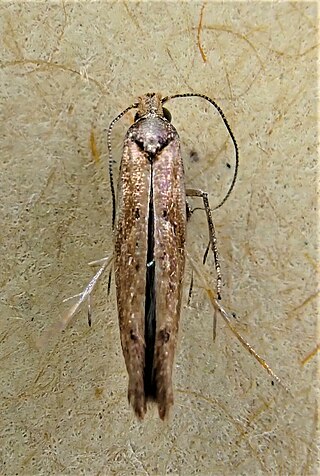
Zelleria porphyraula is a moth in the family Yponomeutidae. It was first described by Edward Meyrick and is endemic to New Zealand. This species has been observed in both the North and South Islands. The adult of the species is on the wing in November and April.























